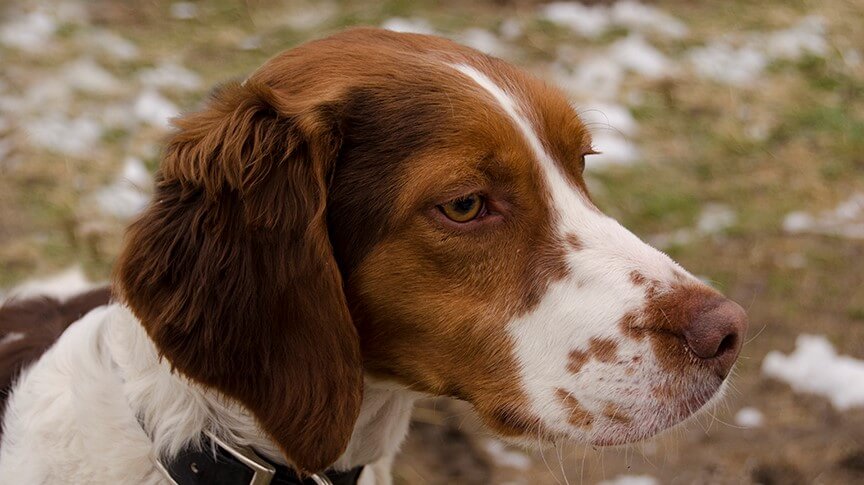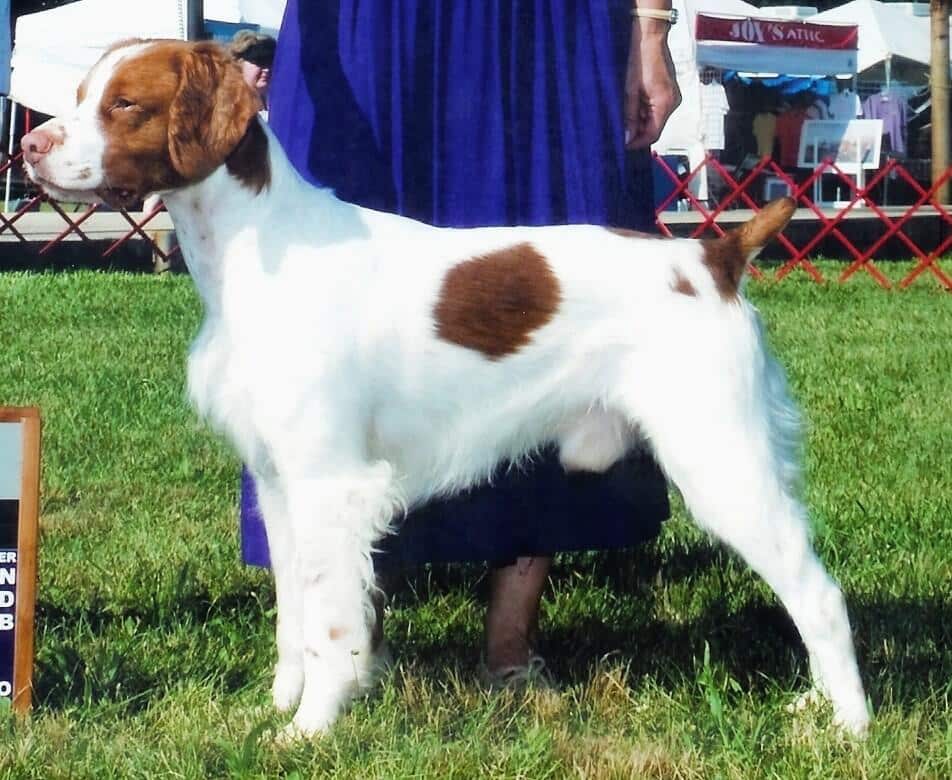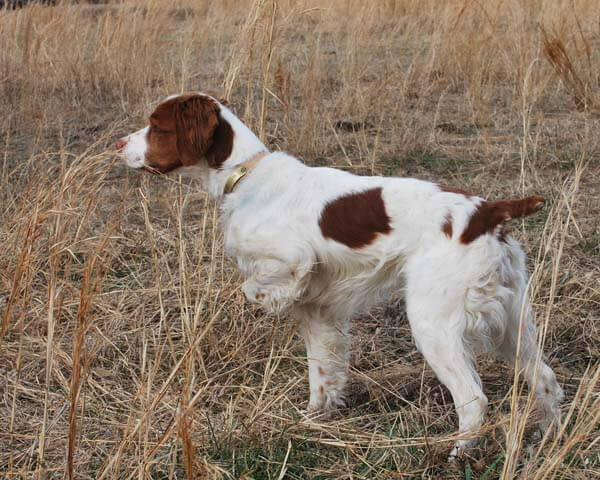
Home » Brittanys & The Pet Peeves of a JEC

This article was originally published in Showsight Magazine, April 2017 issue.
I am the Judge’s Education Chair for the American Brittany Club, a position I have held for several years now. My qualifications came from work both in the show ring and the field, having handled dogs to their titles in both. I believe that the Brittany is and always should be a dual dog. As the JEC, I often receive an onslaught of Monday morning notices after a long dog show weekend—the bing of a text, the beep of an email, the ringing of the phone. My biggest pet peeve is everyone thinking I can fix everything for them. I am often heard saying, “I just teach judge’s education, I can’t make them judge the way I’d like.” In the interest of education, I’d like to clear up a few of the finer points on judging this dual dog.
This is what our standard says about the bite, “Bite—A true scissors bite. Overshot or undershot jaw to be heavily penalized.” It doesn’t say full dentition, count teeth or the teeth should be a specific size. AKC has a really nice sheet that tells you how and what to exam in reference to bite. It’s called “Conducting Oral Exams.” This is what the first part says, “The proficient judge alters their examination technique from breed to breed based on the priorities as defined by the standard. It should never be identical from breed to breed to breed. To do so requires interpretation of the written word as to what the standard is attempting to convey to you as the judge. The manner in which a breed’s approved standard is written will define what would constitute conducting a breed specific examination. Close inspection of a breed’s approved standard will determine the appropriate oral exam to conduct when judging that breed, which is an essential component of the breed specific exam. Oral exams can be generally divided into four categories which individually or in combination will constitute the proper oral exam for a breed:
More on the bite exam: it is proper when the standard only refers to the alignment of the bite; scissors, level and undershot or overshot, as a preference, fault or DQ. This requires the exhibitor or judge separating the front of the lips to display the meshing of the incisors and canines. Judges that is all you need to know about judging a Brittany’s bite. Then I don’t get some of those Monday calls. I have to tell you that this is one of the biggest complaints I hear.
“Slow down, don’t go so fast, you aren’t off to the races!” Okay, exhibitors, sometimes the judge is right! With that being said, I’ve taught conformation classes for years and one of the things I tell everyone, no matter what the breed, is that you need to move the dog at its best speed. A Brittany is a field dog as well as a show dog and one of the most versatile breeds. In the field, it is required to run all day hunting, 30 minutes or 60 minutes in a field trial and about 20 minutes in a hunt test. The standard says, “When at a trot the Brittany’s hind foot should step into or beyond the print left by the front foot. Clean movement, coming and going, is very important, but most important is side gait, which is smooth, efficient and ground covering.”

The Brittany is an athlete and shouldn’t take little bitty steps, it should gait freely. While most handlers will try to do as a judge has asked, sometimes it’s just impossible. Those dogs that are well conditioned will move out! Exhibitors: start out walking a couple of steps and then bring the dog into a trot. As you approach the judge, slow down so that you can bring the dog to a natural free standing position and if possible try to show the judge both sides of your dog.
That leads into my next item, the piebald pattern. One spot in the wrong place can throw off the eye. Judges please try to view both sides of the dog. Sometimes the view from the opposite side give you a truer picture of the dog. The same applies to a dog that you think may be a little long in the body. It could be the markings and not the dog itself.
There is sometimes confusion about the Tri-Color Britt. The standard says, “Tricolors are allowed but not preferred. A tri-color is a liver and white dog with classic orange markings on eyebrows, muzzle and cheeks, inside the ears and under the tail, freckles on the lower legs are orange. Anything exceeding the limits of these markings shall be severely penalized.”
I emphasize “orange” because we are beginning to see both orange and liver freckles on the lower legs. We are seeing some really nice Tri’s these days. Our standard is specific if there are two equal dogs in all ways and one is Tri and the other is not, the Tri is a second- place dog. I get lots of arguments from breeders and exhibitors on this. I didn’t write the standard, I just teach what it says and since I’m also on the standards committee I say this, when you breed two dogs that you know produce Tri together, you have a choice. If you choose to do the mating and keep a Tri, you know that you are fighting an uphill battle. We have some really nice Tri champions out there today, so it can be done. When Tri’s were first allowed in our standard we had a huge problem with mismarked Tri’s. Dorothy MacDonald wrote an article for the AKC Gazette and the American Brittany Magazine, talking about the Tri. She said that if the dog is mismarked you write in your book mismarked Tri and excuse it from the ring. Most judges put it in last place hoping to preserve the points.

From the standard, “17½ to 20½ inches, measured from the ground to the highest point of the shoulders. Any Brittany measuring under 17½ inches or over 20½ inches shall be disqualified from dog show competition.”
Please don’t walk up and measure on your leg! If you changed your shoes, you changed your measurement. We have wickets for measuring. In our JE seminars and workshops we have you measure a dog so we know you can. Your objective is to be measuring a dog in, not out. Questions come up all the time about six-month-old puppies. Some breeds give some leeway there, we don’t. If you are exhibiting a puppy at six months, they must be at least 17½ inches at the withers. I get lots of teary phone calls about puppy being measured out by newbies. Then it’s my job to explain and refer them to the standard. We only have two disqualifications: black in the nose or coat or under 17½ or over 20½ inches in height.

Unless judge’s education is held in conjunction with a judge’s institute, the American Brittany Club does not charge for judge’s education. We realize that judges spend lots of money passing AKC’s qualifications to judge and we are just thankful that they want to judge our wonderful breed. Visit the AKC or ABC website for additional information on coming to a Brittany seminar.